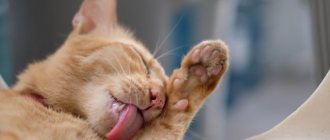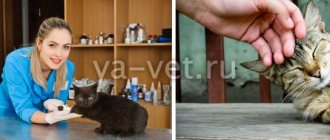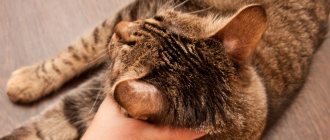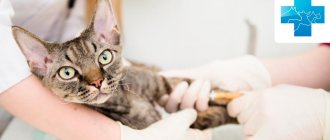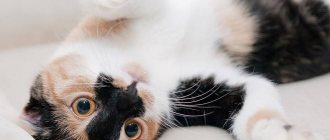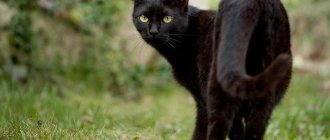Many wild and domestic cats are carriers of an enteritis pathogen (coronavirus), which does not cause any clinical signs in them.
It does not pose a threat to humans and other animal species and rarely leads to the death of a four-legged pet.
However, a mutation of the virus causes a secondary disease, feline infectious peritonitis (FIP), which is fatal. Why the disease affects certain animals is unknown.
Young and elderly individuals (over 10 years old) are especially susceptible to the pathogen.
The disease is common in places where four-legged animals are crowded (shelters, exhibitions, pet stores, nurseries).
Infection occurs through prolonged contact of a healthy mammal with the secretions of a patient.
Description of the disease
FIP in cats is an infection of the intestines and peritoneum. The disease is extremely dangerous for animals, the chances of survival are low. If a sick pet interacts with other cats, there is a risk of infection, although not all contacts become ill.
The main symptoms of viral peritonitis in cats are abdominal pain, refusal of food and water, lethargy and rapid deterioration of the condition. Even if the owner contacts a veterinarian in a timely manner, the chance of death of the animal remains high, and this is the main danger of peritonitis.
The exact causes of the disease have not yet been clarified. It is known that feline peritonitis is caused by the feline variety of coronavirus, which mutates under the influence of stress, change of environment or other harmful factors. Before mutation, the virus can remain in the body of an infected animal for several months or years. The mechanisms of mutation of a non-dangerous virus into the causative agent of a fatal disease have not been established.
Viral immunodeficiency (FIV, FIV)
This is an infectious chronic disease of cats with irreversible damage to the immune system and high mortality. The virus is widespread throughout the world due to the lack of specific treatment and developed vaccines.
The main carriers of the infectious disease are adult and elderly cats (over 5 years old). The virus is transmitted through animal bites (saliva, blood), as well as through mutual licking of cats.
Symptoms of the development of viral immunodeficiency are similar to leukemia:
- decreased activity in a sick pet;
- low appetite and weight loss;
- persistent diarrhea;
- inflammatory diseases of the oral cavity;
- neoplasms in the lymphatic system;
- superimposition of secondary infections.
If a sick cat is diagnosed with Viral Immunodeficiency, the pet should be isolated and given symptomatic treatment using immunomodulators. You also need to avoid contact with healthy cats.
Expert opinion
Chepa Natalya Semenovna Veterinarian Ask an expert Infected animals are recommended to be kept at home without walking, castrated, fed with industrial feed to eliminate the risk of contracting infections through raw meat or fish. If your animal is diagnosed with FIV, but its general condition is satisfactory, and the examination did not show any abnormalities, then the pet has every chance of living a long life. It is necessary to take blood tests (clinical and biochemical) and a general urine test once every six months, as well as an abdominal ultrasound and chest x-ray once a year. Sick cats are not recommended to use drugs that suppress the body's immune system, only if there is a confirmed diagnosis requiring such therapy.
Is there a risk of getting infected from a sick animal?
Feline coronavirus exclusively affects cats. There is no risk for humans. Even immunocompromised people, young children and pregnant women do not become infected with peritonitis.
Also, the disease is not transmitted to dogs, rodents, birds, reptiles and other domestic animals. It is only dangerous for cats. But even within the species, contagiousness is low. A sick animal needs to be isolated from its relatives; after it has been cured or died, the rest of the cats in the house need to be quarantined for 2-3 days. Some experts consider this measure optional.
From FECV to FIPV
FECV affects the cells of the small intestine, kittens aged 1-3 months are susceptible, they develop diarrhea, then vomiting. With timely treatment, the animal recovers, but remains a virus carrier for a month. Therefore, such a kitten is isolated from other cats (quarantine).
FECV is transmitted through feces and is easily transmitted if multiple domestic cats share the same litter box. To avoid this, you need to wash your home and trays with disinfectants; the virus quickly dies.
In the wild or nurseries, the virus spreads quickly if basic sanitary and hygienic rules for keeping animals are not followed. The virus persists in feces for up to 7 weeks.
FECV is considered a common disease, but not all breeders go to veterinary clinics for it. Enteric coronavirus is characterized by mild symptoms and often self-recovery, so the disease does not attract the attention it deserves.
According to research, relatively mild FECV can mutate into a severe form of FIPV, infectious peritonitis virus. As a result of mutation, it gains the ability to quickly spread throughout tissues and organs, causing IPC. According to statistics from the RosVet Center, a similar mutation of FECV to FIPV occurs in 10-12% of cases. This is why it is necessary to treat coronavirus enteritis.
Routes of infection
Cats become infected with coronavirus infection from a sick animal. Since the virus lives in the intestines, the main route of infection is fecal-oral. The infection enters the body by sniffing feces, licking fur, or examining marks. A less common route of spread is airborne droplets. An animal can become infected with the virus in a nursery, in a foster home, or in a veterinary clinic, if contact between cats and each other is not excluded.
Kittens become infected from their mother. This occurs in utero or after birth during care of the offspring. As a rule, the entire litter of a sick cat is affected. A cat, if it does not live in the same apartment (as happens with breeders), does not transmit the virus to its offspring.
FIP in cats can be asymptomatic or mild, but the animal remains a source of infection for life.
If there is only one cat in the house, there is nothing to be afraid of; if there are several, then everyone will be infected. A sick animal should be excluded from breeding and should not be allowed to come into contact with the kittens of other females.
Epidemiology. Prevalence of infection
FIV is distributed worldwide in domestic and wild cats. The cat population is 2-30% depending on the region. Among healthy cats it is about 2-4%, among sick cats – 14-30%. More common among adult, unneutered, outdoor cats. The strains of wild and domestic cats are different. Most likely, a lentiviral infection of wild cats (panthers, lions) occurred primarily. The virus was described in 1986, the infection of domestic cats has probably been around longer - at least since 1966. Epidemiology of FIV in cats. Epizootology. Transmission of infection. Under natural conditions, the main route of transmission of the FIV pathogen in cats is through saliva and blood from bite wounds. Transplacental and nutritional transmission of infection is possible, but of little significance. Under experimental conditions, transmission of infection is possible by any parenteral route (s.c., i.m., i.v., i.p.), transplacentally, nutritionally (orally, rectally), sexually, or by blood contact.
Classification according to the form of the disease
The disease manifests itself in two main forms - effusion and dry. In both cases, the abdominal organs are affected, less often the chest is involved.
Exudative FIP in cats occurs rapidly, with high fever. Fluid accumulates in the peritoneal cavity, and the abdomen increases significantly in size. If the pleural cavity is affected, breathing and heart function are impaired. This form is easier to recognize, but difficult to manage with treatment.
The dry form of the disease is more difficult to diagnose. With it, small foci of inflammation appear on the surface of the intestine, peritoneum, and less commonly, the pleura and pericardium, which turn into dense nodules. There are no noticeable external changes in the pet, but the condition is gradually worsening.
FIP in cats: symptoms
Symptoms of the disease are divided into those that always appear, and those characteristic of a certain form and location.
Persistent signs of FIP in cats:
- The animal sleeps more than usual.
- No appetite.
- He tries to hide in warm corners and curl up.
- High temperature – hot dry nose, hot paw pads.
- Trembling as if cold.
- The mucous membranes of the mouth and eyes become pale.
- Weight gradually decreases.
The effusion form is characterized by an increase in the size of the abdomen. When moving, especially jumping from a height, a gurgling sound may be heard. The dry form of feline infectious peritonitis occurs with stool disorders and frequent vomiting.
In addition to the intestines, other organs, most often the lungs, can be affected. In this case, the cat develops noticeable shortness of breath and breathing becomes hoarse. The pet cannot run and begins to choke. Rare forms - brain damage with the development of paralysis and behavioral abnormalities, inflammation of the iris.
Good to know
- Cat plague (diagnosis, treatment, vaccination, epizootology). How to avoid infecting your pet with feline distemper?
- Panleukopenia in cats (etiology, prevention, therapy, disinfection, vaccination). What to do after panleukopenia?
- Viral Leukemia in Cats (Etiology, Symptoms, Diagnosis, Treatment, Prevention, Vaccine, Tests for Leukemia in Cats)
- Leptospirosis in cats (distribution, etiology, pathogenesis, symptoms, diagnosis, treatment and prevention). Vaccination against leptospirosis in cats
- Viral leukemia in cats (symptoms and treatment). How to help a cat?
- Hemobartonellosis in cats and dogs (epizootology, pathogenesis, diagnosis and treatment). Biological properties of Hemotropic Mycoplasmas in cats (Mycoplasma Haemofelis, Mycoplasma turicensis). Control and prevention measures for hemobartonellosis in cats
- Borreliosis in animals and humans (etiology, diagnosis, spread, causes, therapy, signs and symptoms, prevention). Lyme disease in dogs and other animals
- FLV in cats (epizootology, etiology, diagnosis, differential diagnosis and treatment) FeLV for cats (causes, vaccination, prevention and therapy)
- Viral leukemia of cats (etiology, epizootology, diagnosis, therapy, prevention). What to do if my cat is sick with the leukemia virus
How long do cats with peritonitis live?
The lifespan of a cat with coronavirus depends on the form of the disease and the timeliness of treatment. The wet form is fatal within six months, while the dry form can last up to 5 years. The later peritonitis is detected, the less likely the pet is to survive. Under the most favorable circumstances, the risk of death approaches 85%; if the disease is detected late, then the mortality rate is 100%.
An animal cannot recover from peritonitis. All efforts of veterinarians are aimed at maximizing the life of the furry animal.
Diagnostics
If your cat's health is in doubt, you can try to examine it yourself. Some signs of peritonitis are visible even to a non-specialist. You cannot palpate your pet’s belly yourself - this is a painful procedure; the domestic predator will resist and is capable of causing serious scratches and bites to the owner. The cat must be taken to the veterinarian.
Tests to detect feline infectious peritonitis:
- A general analysis of blood, urine and feces reveals the presence of an acute inflammatory process.
- ELISA and ICA are immunological blood tests that detect antibodies to the virus.
- PCR – finds the genetic material of the virus. Feces or peritoneal effusion is used.
Treatment regimen
The main goal of FIP treatment is to prolong and facilitate the cat's life. It is impossible to completely rid the animal of the disease, but it can be allowed to live the remaining months or years without suffering.
As in humans, several groups of drugs are used - etiotropic to fight viruses, pathogenetic to slow down the development of the disease, symptomatic to improve well-being and prophylactic to avoid complications.
- Etiotropic therapy is aimed at slowing down the replication of the virus. Feline antiviral drugs are used - Enterostat, Fosprenil and others. The exact dosage is calculated based on the weight of the animal and its condition.
- Anti-inflammatory drugs of the steroid and non-steroidal series and drugs to enhance immunity are used as pathogenetic agents. Intravenous infusions of saline and nutrient solutions are also used. Their task is to maintain fluid balance in the cat’s body, to provide nutrition in case of decreased appetite or complete inability to eat from a bowl.
- To alleviate the animal's condition, vitamin preparations and painkillers are prescribed. Their administration allows the pet to feel relatively well and slow down the deterioration of the condition. To combat complications, antibiotics and drugs that support the functions of the kidneys, liver and lungs are used. They are prescribed as needed.
All medications are prescribed in the form of injections and droppers, so the cat will have to be treated at a veterinary clinic. The owner can give intramuscular injections at home. To do this, you need an assistant who will hold the cat. The injection site is just above the base of the hind paw. If the owner cannot perform the injection himself, it is better to entrust this to a veterinarian. Intravenous injections and infusions are only allowed in a veterinary clinic.
To alleviate the condition of effusion peritonitis, a therapeutic puncture is performed. Fluid is drained from the abdominal cavity through a special tube, giving the cat the opportunity to eat and move normally. This procedure must be carried out regularly. The danger of puncture is the risk of infection and the development of bacterial peritonitis, which leads to the rapid death of the pet.
Can a vaccine protect a cat?
There is a vaccine against the non-mutated form of feline coronavirus. It protects pets from other diseases caused by the same pathogen - enteritis and infection. But if the pet has already been in contact with an infectious relative, vaccination loses its effectiveness.
The vaccine is administered in the form of drops into the kitten’s nose; vaccination time is 3.5-5 months.
If the mother of the kittens was infected, then vaccination is useless; the kittens themselves have become carriers of the infection, have been ill or are at risk of a severe form of the disease.
The vaccine is ineffective against peritonitis; vaccinated cats get it just as much as unvaccinated cats. It is not yet possible to develop a remedy that would help avoid the fatal cat disease. We can only hope for prevention in healthy people and timely diagnosis in sick people.
Vaccination
The FIP vaccine Primucell has been shown to be effective (50-70% effective) in cats over 16 weeks of age. It is not effective for kittens under 16 weeks of age or cats positive for coronavirus. It is also not effective when used on animals coming from breeding facilities with endemic coronavirus, possibly because they are already infected with it. The Primucel FIP vaccine causes the formation of an immune response in cats to the feline peritonitis virus, 4 weeks after a double dose, lasting at least 12 months. The vaccine is harmless and has no medicinal properties.
Kittens are vaccinated from 16 weeks of age twice with an interval of 3 weeks. Subsequent revaccinations of animals are carried out annually with one dose of Primucel FIP vaccine - 0.5 ml. After vaccination, nasal discharge and a slight increase in body temperature may appear for 1-2 days. After administration of the Primucel FIP vaccine, an allergic reaction may develop. In this case, the animals are given appropriate symptomatic therapy. The immune response can be reduced in animals that have been exposed to stress (transportation, regrouping, etc.), are in unfavorable environmental conditions, are not fed properly, and are not following the instructions for using the vaccine.
Cats living in households in groups of 1 to 3, where the expected probability of developing FIP is only about 1/5000, are the group that will develop the best immunity from the Primucell vaccine, but its use in this environment will be quite ineffective in reducing the incidence cases of FIP in the entire cat population. For example, if a vaccine is 50% effective, 10,000 animals would need to be treated with it to save one from the infection. Some cattery owners have experimented with the use of the Primucell FIP vaccine in six-week-old kittens, on the assumption that since kittens at this age lose maternal immunity, they will be able to mount an immune response to coronavirus vaccination, and that by thus preventing coronavirus infection, it will be possible to avoid disease with its mutant form of FIP. To date, such experiments have demonstrated a reduction in the incidence of virus carriage in vaccinated animals, but not a reduction in the mortality of kittens from FIP. It remains to be assessed whether the benefits of vaccination outweigh the risks of vaccinating very young kittens. One of the possible risks is the recombination of coronavirus strains into new, even more virulent ones.
